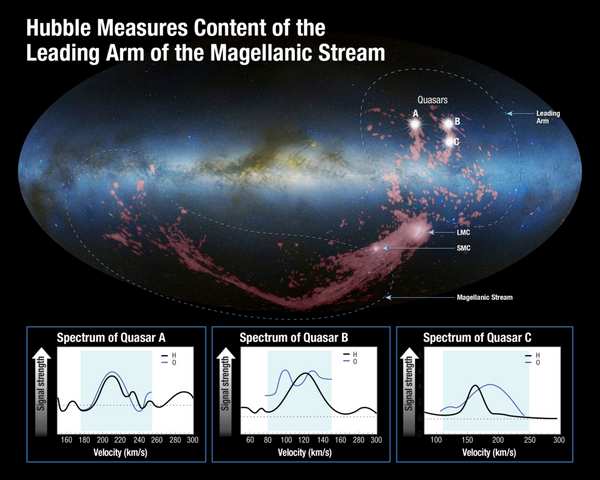Two dwarf galaxies, the Large Magellanic Cloud and the Small Magellanic Cloud, orbiting our galaxy, as well as each other. One of them has pulled a huge cloud of gas from the other, called the Leading Arm because it leads the motion of the Magellanic Clouds. The arching collection of gas connects the Magellanic Clouds to the Milky Way galaxy and is thought to be 1 or 2 billion years old.
The question is which of the 'fighters' is pulling from the other the concentration of gas, devoured by the Milky Way and feeding new star birth in our galaxy. It now appears the 'bully' has been identified by researchers.
"There's been a question: Did the gas come from the Large Magellanic Cloud or the Small Magellanic Cloud? At first glance, it looks like it tracks back to the Large Magellanic Cloud. But we've approached that question differently, by asking: What is the Leading Arm made of? Does it have the composition of the Large Magellanic Cloud or the composition of the Small Magellanic Cloud?" explained lead researcher Andrew Fox of the Space Telescope Science Institute in Baltimore, Maryland.
The scientists have found that the gas matches the Small Magellanic Cloud, indicating "the Large Magellanic Cloud is winning the tug-of-war, because it has pulled so much gas out of its smaller neighbor."

Fox and his team used Hubble's ultraviolet vision to chemically analyze the gas in the Leading Arm. The scientists observed the light from seven quasars, the bright cores of active galaxies that reside billions of light-years beyond this gas cloud. Using Hubble's Cosmic Origins Spectrograph, they measured how this light filters through the cloud.
Hubble's unique ultraviolet capability made it possible to discover the answer. Due to the filtering effects of Earth's atmosphere, ultraviolet light cannot be studied from the ground.
"Hubble is the only game in town. All the lines of interest, including oxygen and sulfur, are in the ultraviolet. So if you work in the optical and infrared, you can't see them," Mr. Fox said.
The study by researchers is valuable as it shines light on how gas gets into galaxies, fueling star birth. In this case, gas from the Leading Arm is now crossing the disk of our galaxy, interacting with the Milky Way's own gas, becoming shredded and fragmented.

